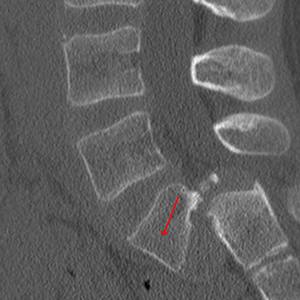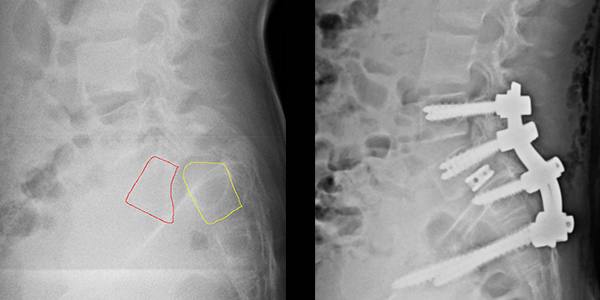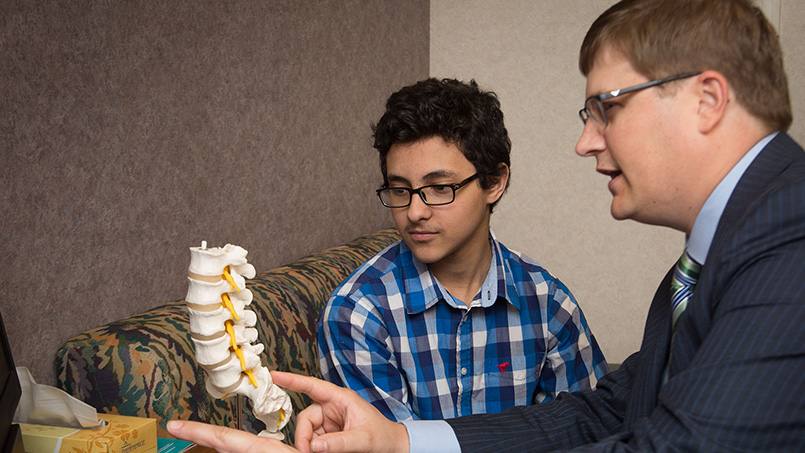-
Children's Center
Sharing Mayo Clinic: Spinal surgery saves teen swimmer’s mobility
When the position of his spine unexpectedly changed, 13-year-old Albert Mansour was unable to walk without discomfort. Using a unique surgical approach, Mayo Clinic surgeons were able to successfully repair Albert's spine and relieve his pain.
When 13-year-old Albert Mansour first walked onto Mayo Clinic's Rochester campus in the fall of 2016, the steps he took were peculiar, painful and incompatible with the physique of the competitive swimmer he had been just a year earlier.
Albert, who lives with his family in Inver Grove Heights, Minnesota, walked bent-kneed and on his toes. His legs were angled awkwardly, and his lower back flattened to accommodate a lumbar vertebra that had slipped forward and down onto the vertebra directly beneath it. He had back pain and sciatica nerve pain. His nerves were stretched taunt by his condition, known as spondylolisthesis.
"Spondylolisthesis, overall, is fairly common," says Todd Milbrandt, M.D., in Mayo Clinic's Department of Orthopedic Surgery. "But the kind that Albert had, which was nearly a complete slippage of the fifth lumbar vertebra onto the first sacral vertebra, is relatively rare."

The spines of those affected by the condition lose their stacked-block structure when the bottom lumbar vertebra shifts down onto the top of the sacrum, which causes the pelvis to angle downward.
"That's the foundation of the whole spine, and Albert's vertebra had shifted toward the front and was putting a lot of pressure on his nerves. That was causing his walk to change," says Dr. Milbrandt.
Albert's spinal surgeon at Mayo Clinic Jeremy Fogelson, M.D., in the Department of Neurosurgery, explains that there is a grading system for the condition.
"There are five grades, and he was a grade four out of five, which is quite severe," Dr. Fogelson says.
For individuals with high-grade cases of spondylolisthesis like Albert's, an intensive surgery that includes laminectomy and spinal fusion is the best option to correct the defect.
Following a day-long operation in December 2016 — during which Albert's surgical team members, including Dr. Fogelson and Dr. Milbrandt, corrected Albert's misaligned vertebra and released the tension on the nerves to his legs — the teenager is moving normally again and looking forward to getting back into the swimming pool.
Damage and debilitation
Albert's medical problems started in late 2015. He was active on his junior high school swim team, but he began having trouble completing his swimming stretches, says Albert's father, Ramy Mansour. His parents brought him to the family's primary care physician, who attributed Albert's pain to his legs growing longer.
A few weeks after that appointment, however, Albert began walking on his toes. Albert went back to the doctor. An X-ray and referral to an orthopedic specialist were ordered. The specialist visit yielded a diagnosis of spondylolisthesis and a referral to an orthopedic surgeon.
All the while, Albert's symptoms continued to worsen. His gait became more awkward, his pain increased and he was forced to stop swimming.
"After we met with Dr. Fogelson, I asked Albert, 'What do you think?' and he said that he wanted to do the operation at Mayo Clinic." — Ramy Mansour
"Last year we discussed (with Albert's local surgeon) that Albert needed to do the operation, but he was a little stressed about doing it," Ramy says. "Although the surgeon we met was an excellent guy, Albert was still very stressed."
Albert's outlook changed after his Mayo Clinic visit.
"After we met with Dr. Fogelson, I asked Albert, 'What do you think?' and he said that he wanted to do the operation at Mayo Clinic," Ramy says. "Dr. Fogelson handled this with Albert in an excellent way. Albert was very happy to do it there, and we were as well."
Repair and recovery
There was a time that surgeons were hesitant to restore alignment for people who had spondylolisthesis, says Dr. Milbrandt, adding that Mayo Clinic surgeons now perform such operations more frequently.
The procedure, called spinal decompression surgery, requires physicians to remove a portion of the back of the vertebra, or lamina, to create room in the spinal column and take the pressure of the nerves. Next, surgeons use screws and rods to slowly coax the slipped vertebra back into place.

"By doing a decompression, the nerves that go down legs are free," Dr. Milbrandt says. "For a long time, no one attempted the operation because the complication of losing the nerve function permanently was common, and the risk was very high."
Dr. Fogelson explains that Mayo Clinic surgeons employ spinal monitoring throughout the operation to make sure the nerves are safe.
"The patient is still under anesthesia and asleep, but we use electrical signals and record the brain waves and muscle twitches to make sure the signals are still getting through the nerves," Dr. Fogelson explains.
To ensure Albert's vertebra remains in place, a bone graft was placed onto the problem lumbar vertebra to fuse it with the bones immediately above and below it.
"Because of the complicated and rarer nature of the operation, working as a multidisciplinary team with Dr. Milbrandt was helpful. This is something we frequently do at Mayo Clinic, bringing together doctors from multiple specialties to maximize the quality of care," Dr. Fogelson says. "Although Albert first saw me, and I specialize in the treatment of spinal deformities, I felt we could provide the best care possible if Dr. Milbrandt and I performed Albert's surgery together."
As expected, Albert woke up from his surgery in significant pain. But by the fourth day after surgery, his pain had mostly receded, and he was walking without any assistive devices.
"The key is, if you can get them walking, the bodily functions return and the pain gets better," Dr. Milbrandt says. "But at first patients are usually hesitant to get out of bed because they're afraid of the pain worsening."
"Because of the complicated and rarer nature of the operation, working as a multidisciplinary team with Dr. Milbrandt was helpful." — Jeremy Fogelson, M.D.
Albert was discharged six days after his surgery, and the family was overjoyed to be able to attend Christmas Eve mass together, Ramy says.
"Albert is essentially back to normal," Dr. Fogelson says. "We have him on some restrictions for now to not overstress his fusion. But otherwise from the outside, you couldn't tell anything different about him. He's hopefully cured."
To Albert and his family, the ability to go to Mayo Clinic and witness the care Albert received was the experience of a lifetime.
"I used to be a specialist of internal medicine for about 20 years in Egypt before moving to the United States, and we know as students of medicine that Mayo Clinic is one of the most eminent names on our planet," Ramy says. "Its reputation is beyond excellent. It was just a dream."
HELPFUL LINKS
- Explore Mayo Clinic's Department of Neurosurgery.
- Read more about the Department of Orthopedic Surgery.
- Connect with others talking about spinal surgery on Mayo Clinic Connect.
- Visit Mayo Clinic's Rochester campus.
- Request an appointment.
Related Articles








